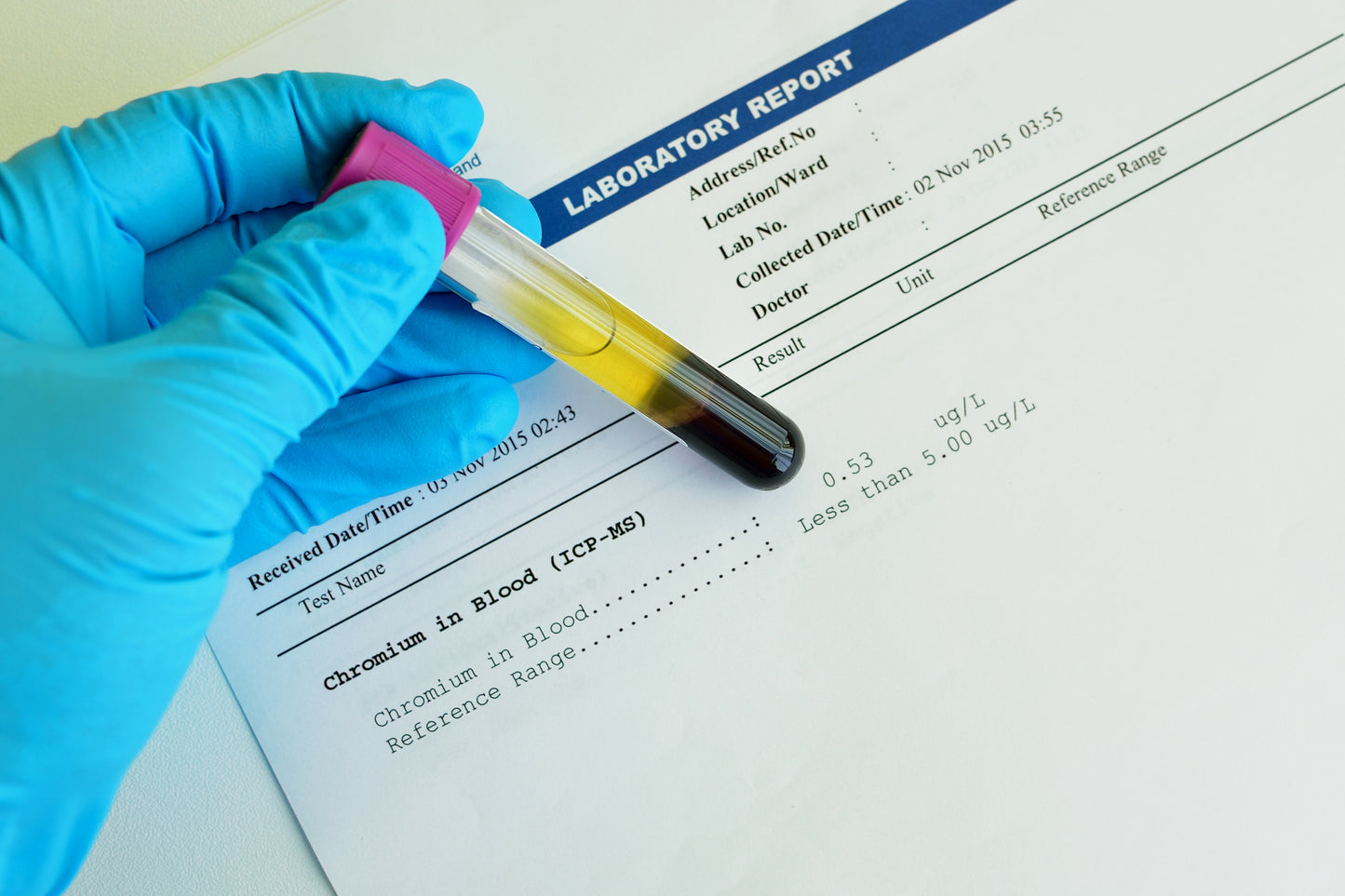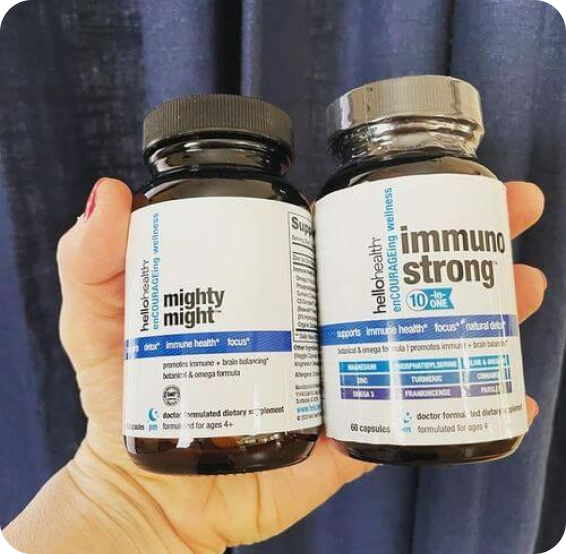hellohealth
Heavy Metals
Heavy Metals
Brief Description: A Heavy Metals Panel Blood test is a diagnostic tool that measures the levels of various heavy metals in the blood. This panel includes testing for lead, mercury, and arsenic. Heavy metals are elements with high atomic weights that can have toxic effects on the body even at low concentrations. This test helps identify exposure to these toxic substances and assess the potential health risks associated with them.
Also Known As: Toxic Metals Test, Heavy Metals Blood Test
Collection Method: Blood Draw
Specimen Type: Whole Blood
Test Preparation: Avoid seafood consumption for 48 hours prior to sample collection

Customer Reviews (% reviewsData.profile_link_title %)
0 Review
When is a Heavy Metals Panel test ordered?
If a medical professional believes that a patient has been acutely or chronically exposed to one or more heavy metals, a heavy metals panel may be prescribed. Depending on the type and amount of metal involved, the nature and severity of the signs and symptoms of heavy metal exposure will vary; early signs of poisoning can be missed because they are frequently non-specific. Even if a person has no, few, or vague symptoms, excessive exposure can nonetheless cause harm to numerous organs.
Those who might be exposed to metals at work are typically periodically observed. Safety precautions reduce danger to workers and aid in resolving issues when they arise. Several dangerous metals that can be present at work are regulated by the U.S. Occupational Safety and Health Administration. The affected individuals are monitored and action is made to lessen their exposure if excessive quantities are found.
What does a Heavy Metals Panel blood test check for?
A heavy metals panel is a collection of tests that assesses the levels of particular potentially harmful metals in blood, urine, or, less frequently, hair or other body fluids or tissues. A laboratory might offer tests for individual metals as well as various groupings of heavy metals panels. Lead, mercury, and arsenic are the most typical mixture. Other panels might contain one or more other metals, such copper, zinc, or cadmium. In addition to considering the patient's clinical symptoms, a healthcare professional will decide which metals to test for depending on possible exposure.
The definition of "heavy metals" is ambiguous. It refers to a number of elements with high density or metallic qualities and is connected to the periodic table of elements. These substances are naturally present throughout the environment, and businesses employ them to create a variety of everyday goods. Some of them, such as copper, iron, molybdenum, selenium, and zinc, are required in tiny amounts by the body for regular function but can be harmful at higher levels. Any of the heavy metals can irritate or harm the body in high doses, and they can contaminate the soil, air, food, and water as well as linger in the environment for a very long time. The terms "heavy metals" and "toxic metals" are commonly used interchangeably because they are a potential source of harm.
The signs and symptoms that an individual may suffer are influenced by the type of metal, its form, the quantity, the time of exposure, the type of exposure, the individual's age, and the general health of the individual. One form of a metal may be more dangerous than another, such as an organic vs an inorganic metal compound, and some metals are significantly more toxic than others. The amount of metal absorbed and the areas of the body that are impacted can vary depending on how a person is exposed. For instance, a metal may be far more poisonous and cause serious lung damage when its fumes are inhaled than it may be when it is held in the hand or is just moderately dangerous and poorly absorbed when consumed.
Moderate exposure over time should also be evaluated because severe acute exposure can harm you and, in some situations, be fatal. Small amounts of heavy metals can be processed by the body, but moderate to large levels can build up in the kidneys, liver, bones, and brain. Some metals can impair the body's capacity to create red and white blood cells and are thought to be carcinogenic, which increases the risk of developing cancer. Because exposure to low or moderate concentrations can disrupt physical and cognitive development and can irreparably damage the organs and brain, fetuses and young children are most at danger. A significant portion of the metals can be transferred from the mother to the fetus, and some can be transferred to the baby through breast milk.
Lab tests often ordered with a Heavy Metals Panel test:
When a Heavy Metal Panel is ordered, it's often part of a broader evaluation of exposure to toxic substances and related health conditions. Here are some tests commonly ordered alongside it:
- Complete Blood Count (CBC):
- Liver Function Test:
- Kidney Function Test:
- Urinalysis:
- Iron Studies:
- Vitamin and Mineral Levels (e.g., Zinc, Calcium, Magnesium):
- Basic Metabolic Panel (BMP):
These tests, when ordered alongside a Heavy Metal Panel Blood test, provide a comprehensive assessment of potential toxic exposure and its impact on health. They are crucial for diagnosing and managing heavy metal poisoning, assessing organ function, and guiding detoxification and treatment strategies. The specific combination of tests will depend on the individual’s exposure history, symptoms, and initial test results.
Conditions where a Heavy Metals Panel test is recommended:
- Urine Heavy Metals Test: This test helps assess heavy metal exposure and elimination by measuring the concentration of metals in the urine.
- Blood and Urine Creatinine Levels: These tests are often performed alongside heavy metals testing to assess kidney function and determine if there is a need for chelation therapy (a treatment to remove heavy metals from the body).
How does my health care provider use a Heavy Metals Panel test?
For people who may have been exposed to one or more heavy metals, heavy metal testing is used to check for or diagnose heavy metal toxicity. It is also used to monitor excessive metal concentrations in people who work with different heavy metals. Construction, mining, radiator repair shops, and shooting ranges are a few examples of these professions. Testing is also done to check how well chelation therapy, a method of getting rid of heavy metals from the body, is working.
A series of studies using heavy metal panels is put up to simulate possible metal exposures. One or more distinct categories for either blood or urine may be available in a laboratory. A medical professional will place an order for the metals panel based on the patient's profession, interests, potential exposure, and/or clinical symptoms.
A doctor may prescribe a specific test in place of or in addition to a panel if they have reason to believe that a patient has been exposed to a particular metal, such as lead. When testing for exposure, lead is frequently ordered on its own, especially in youngsters due to their heightened sensitivity to its effects. Some metals can also be measured in bodily tissues, fluid, hair, and nails. These are often purchased separately.
What do my Heavy Metals Panel test results mean?
The evaluation of heavy metals test results must be done with care. A low concentration of a heavy metal in the blood does not always imply that an excessive amount of exposure has not taken place. Heavy metals do not persist in the blood for a long time and do not linger in the urine. For instance, over time, lead is absorbed into the bones when it moves from the blood into the body's organs. Lead may be found in a person's blood, urine, organs, and bones if they were exposed to lead on a regular basis.
Due to their widespread presence in our environment, several heavy metals may be found in extremely low concentrations in the blood and urine of individuals who appear to be in good health. Age-related recommendations for safe levels of heavy metals can change over time as new knowledge regarding their safety becomes available.
Scientists discovered detectable mercury in nearly 8,000 participants in a research done in 2004 according to the Centers for Disease Control and Prevention, for instance. They came to the conclusion that mercury levels in the blood and urine tend to rise with age. Additionally, they claim that the presence of mercury in detectable amounts in the blood or urine does not necessarily indicate that mercury levels have a negative impact on health. Physicians and public health officials can use reference values from monitoring studies on mercury levels in the body to assess if a patient has been exposed to levels of mercury above those in the general population.
Most Common Questions About the Heavy Metals Panel Blood test:
Clinical Indications and Applications
What are the primary purposes for ordering the Heavy Metals Panel Blood test?
The Heavy Metals Panel Blood test is utilized to detect and monitor exposure to toxic heavy metals such as lead, mercury, cadmium, and arsenic. It's often used in occupational health to assess exposure risk or in clinical settings to diagnose heavy metal toxicity, especially when symptoms of poisoning are present.
How can the Heavy Metals Panel Blood test assist in diagnosing chronic exposure to heavy metals?
Chronic exposure to heavy metals may lead to vague symptoms such as fatigue, neurological changes, or gastrointestinal issues. The Heavy Metals Panel Blood test can help detect chronic exposure by measuring the levels of specific metals in the blood, assisting in diagnosing conditions like chronic arsenic or lead poisoning.
Interpretation of Results
What do elevated levels of a specific heavy metal like lead indicate in the Heavy Metals Panel Blood test?
Elevated levels of lead in the Heavy Metals Panel Blood test may indicate exposure or poisoning. This could be due to environmental factors, occupational exposure, or ingestion of contaminated substances. Elevated lead levels can lead to serious health problems affecting the neurological system, kidneys, and other organs.
How are reference ranges for the Heavy Metals Panel Blood test determined?
Reference ranges for the Heavy Metals Panel Blood test are determined based on generally accepted levels considered safe or normal for each metal. These can vary based on the laboratory and the population, but they typically align with established guidelines by health authorities.
Relationship with Other Medical Conditions
Can the Heavy Metals Panel Blood test provide insights into neurological disorders?
Yes, the Heavy Metals Panel Blood test can provide insights into certain neurological disorders. For instance, exposure to heavy metals like mercury or lead can result in neurological symptoms. The test can identify the presence and levels of these metals, helping in diagnosing and managing related neurological conditions.
How does the Heavy Metals Panel Blood test relate to renal function?
Heavy metals such as cadmium and mercury can adversely affect renal function. The Heavy Metals Panel Blood test can detect these metals and assess the potential risk to the kidneys, aiding in early diagnosis and intervention to prevent or minimize renal damage.
Environmental and Occupational Considerations
How is the Heavy Metals Panel Blood test used in occupational health?
In occupational health, the Heavy Metals Panel Blood test is used to monitor workers' exposure to heavy metals in industries such as mining, manufacturing, or battery production. Regular testing can identify elevated levels early, allowing for interventions to reduce exposure and prevent health complications.
What is the role of the Heavy Metals Panel Blood test in assessing environmental exposure?
The Heavy Metals Panel Blood test plays a vital role in assessing environmental exposure, especially in communities near industrial areas or contaminated sites. By testing individuals or populations, public health officials can identify exposure sources and implement measures to mitigate risks.
Diagnostic Tools and Procedures
How does the Heavy Metals Panel Blood test complement other diagnostic tools like urine testing?
The Heavy Metals Panel Blood test can be used alongside urine testing for a comprehensive assessment of heavy metal exposure. Blood tests typically detect recent exposure, while urine tests may provide insights into ongoing or chronic exposure. Combining both can offer a thorough understanding of the exposure source and duration.
When is the Heavy Metals Panel Blood test typically ordered, and what procedures are commonly performed alongside it?
The Heavy Metals Panel Blood test is typically ordered when there is suspected exposure or symptoms of heavy metal toxicity. It might be performed alongside a clinical examination, history taking, and other laboratory tests, like complete blood counts or renal function tests, to provide a complete picture of the patient's health and the extent of exposure or damage.
We advise having your results reviewed by a licensed medical healthcare professional for proper interpretation of your results.
*Important Information on Lab Test Processing Times: Ulta Lab Tests is committed to informing you about the processing times for your lab tests processed through a national lab. Please note that the estimated processing time for each test, indicated in business days, is based on data from the past 30 days across the 13 laboratories for each test. These estimates are intended to serve as a guide and are not guarantees. Factors such as laboratory workload, weather conditions, holidays, and the need for additional testing or maintenance can influence actual processing times. We aim to offer estimates to help you plan accordingly. Please understand that these times may vary, and processing times are not guaranteed. Thank you for choosing Ulta Lab Tests for your laboratory needs.
The Heavy Metals Panel, Blood test contains 1 test with 4 biomarkers.
The 4 Ways to View Your Results
-

Results Graphed Dynamically
This viewing method allows you to see your test results in a dynamic graph format, visually tracking changes over time so that you can better understand your health trends.
-

Results by Category
This method organizes your test results by category, making it easier to navigate and understand them based on different areas of health or body systems.
-

Functional Reference Ranges
With functional reference ranges, you can view your test results in the context of optimal health ranges rather than just standard laboratory ranges. This can provide a more in-depth perspective on your health status.
-

Results Report
This is a traditional lab report format provided by the lab, offering you a familiar layout of your results that is often used for sharing with healthcare providers.
 Free shipping Over $100+
Free shipping Over $100+









